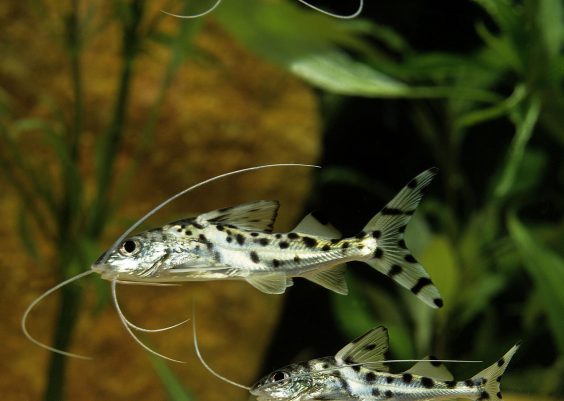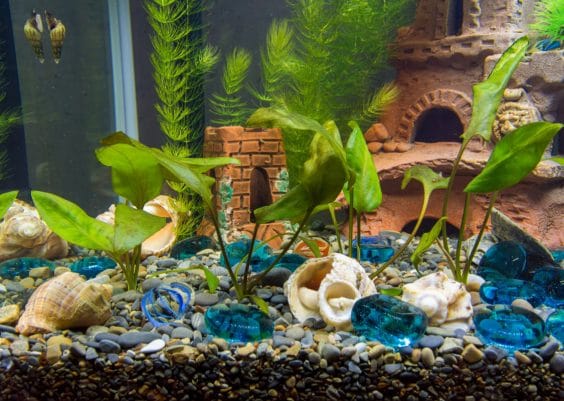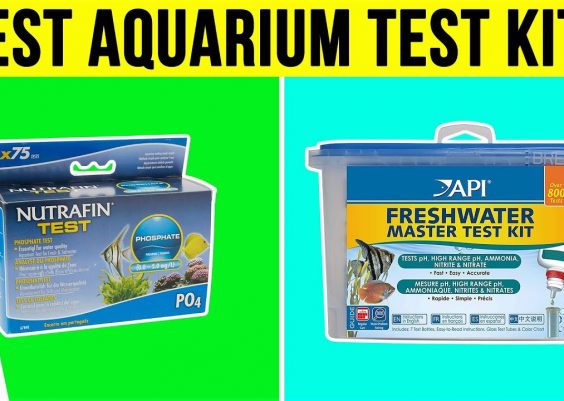Contents
A clean fish tank not only looks incredible but helps maintain the health and happiness of your swimming inhabitants.
Over time, nitrates and metabolites can build up, which might ruin the appearance of your aquarium and harm the well-being of your fish. While every aquarium is equipped with filters, even the best version on the market, they are not enough to keep your tank clear and clean.
That’s why you need to clean a fish tank on a regular basis. Here are some steps and practices for you to do this job with ease. Let’s explore!
What to Prepare for Cleaning a Fish Tank

- Razorblade (plastic blade for acrylic aquariums)
- Algae scraper pad
- Plastic scraper blade
- Razor blade
- Water siphon
- Large buckets
- Lime remover/ glass cleaner (for aquariums)
- Filter media
- Filter brush
- Chlorine remover (aquarium water conditioner)
- Aquarium testing and treatment kit
- Bleach
- Paper towels
A 6-step Guide on How to Clean a Fish Tank

Step 1: Test the water quality
The first step to clean a fish tank is to measure the water quality. If your tank is newly set up and has not been cycled, you need to test the water to know whether it has 0 ppm ammonia, 0 ppm nitrites, and less than 40 ppm nitrates. High levels of these water compounds can be detrimental to fish.
If your aquarium is already cycled, then what you need to do is to keep nitrate levels lower than 40 ppm. Check the nitrates by using a water test kit and find out how much water should be removed.
Step 2: Clean the interior of the tank
After testing the water quality, give the glass a good cleaning on the inside with an algae scraper pad.
There is a number of algae scrapers on the market for you to choose from, from long-handled scrubbers to magnetic scrubbers. It would be best if you bought algae pads at a pet shop rather than the housewares department of a regular store. Even though they might look similar, the housewares pads can contain soap or chemical residue. That residue does not cause a problem if you are cleaning your kitchen sink, but it can be harmful to your little pets.
For stubborn residue on the glass, you can use a razor blade to scrape it off. If your tank is acrylic, use a plastic razor blade instead, because standard ones might scratch the acrylic.
Step 3: Clean decorations and rocks
Once the inside glass is clean, remove rocks, artificial plants, and decorations that have many algae or are dirty. Do not use soap or detergents to clean them. It’s very difficult to remove soap completely, and even a trace can hurt your fish. Scrub with an algae scraper in warm water will get rid of the algae and dirt from plants and rocks.
For more stubborn cleaning problems, soak the items in a 10% bleach solution for 15 minutes. Scrub any remaining residue off, clean it well in water, and let air dry to remove residual bleach. Please do not put them back in the tank until there is no more chlorine smell. Besides, you can rinse them in water that contains dechlorinator (sodium thiosulfate) added to it to eliminate the chlorine.
You can bleach live plants to remove algae from them. However, remember that stem plants cannot tolerate bleaching. To bleach live plants, soak the plants in a 5% bleach solution for 2-3 minutes, then rinse them well.
Leave the plants, rocks, and decorations out of the tank while you vacuum the gravel. Thereby, none of the debris and dirt stirred up from the gravel will settle on them.
Get a new bucket and make it for aquarium use only. If you use a bucket that contains soap or detergent, you could bring unwanted chemicals into your aquarium.
Step 4: Clean the aquarium gravel
Next, you clean the gravel by using a water siphon to vacuum the debris. The gravel vacuum should stir up the gravel and eliminate debris without sucking up the gravel. Make sure you vacuum the whole surface of the gravel completely so that all debris is cleared.
The water clear of the debris will be replaced with dechlorinated water, which makes a water change in the aquarium. Ensure the replaced water has the same temperature as your aquarium water.
Moreover, you should unplug your aquarium heater during water changes to prevent it from being exposed to air because the water level drops. You should change only 25 percent of the aquarium water.
Step 5: Clean the outside of the glass and fixtures
When the inside of the tank is cleaned, cleanse the hood, light, tank top, and outside the glass. Regular glass cleaners have ammonia, which is harmful to the fish. Standard lime cleaners are even more harmful.
Instead, you should use vinegar or a cleaner specified for aquariums, then rinse the surfaces with a clean damp cloth.
Step 6: Clean the filter after two weeks
When the outside is clean, bring the plants, rocks, and other decorations to the tank. Then clean the filter a couple of weeks later. Why is that? Because cleaning a fish tank may disturb the beneficial bacterial colonies on the rocks, plants, and gravel.
Luckily, most beneficial bacteria reside within the filter media, meaning you completely upset the ecosystem. However, if you change the filter immediately, you might cause a dangerous ammonia spike as there are insufficient beneficial bacteria to remove the toxins.
If you have filter media, including carbon, ion-exchange resins, or ammonia absorbers, you should replace it if it’s more than three weeks old. After several weeks, the absorbing qualities of the media might lose, and it cannot serve its purpose.
A medium that works as a mechanical filter rather than capturing toxins (filter fiber, sponges, or ceramic rings) should be carefully cleaned to eliminate debris and returned to the filter. If you use the water having the same temperature as the aquarium water and return the media to the filter, not the entire bacterial colonies growing on them will be lost.
Remember to clean the filter tubing and other parts of the filter assembly. A filter brush can help you clean the sludge that accumulates in all the small crevices.
Conclusion
When you’ve gotten your aquarium in shape, ensure you clean it on a regular basis, so you never need to do a major spring cleaning. Scrape the glass every week, vacuum the gravel whenever you change the water, and clean any plants and rocks as soon as you find algae or debris on them.
Clean the filter every month, either by changing the media or rinsing it. Besides, soak your fishnets in disinfectant solution to clean and soften them. With frequent care, your fish tank will look stunning all the time.





